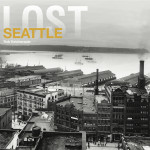Details of the Seattle Electric Company car used in 1912.
As I discovered at the University of Washington Archives, the streetcar used on the HP&LB line in 1912 was rented from the Seattle Electric Company, and was car number 104. Leslie Blanchard's book The Street Railway Era in Seattle indicated that this was a Jackson and Sharp (J&S) car, so I took that info and went to the internet to find archival material.
It ends up that the Delaware Public Archives has a selected sample of the J&S archives, but most of it went to the Smithsonian Institute.
From DPA I received a copy of an after-delivery photo of Seattle Electric Company car number 114, J&S Collection folder 5, photo #23. I'm a bit confused about when and where the photo was taken. The ice and snow seems more appropriate for Delaware than Seattle, but the bodies were shipped without trucks, assembled in Seattle. Car 114 didn't reach Seattle until late March or April 1900, so this would have to be taken the next winter if it's indeed Seattle. Unfortunately advertising in the background is obscured or too small to read and isn't helpful in identifying the location.
From SI I received the purchase book records for SEC's 1899 orders. The original record is in Order Book Electric Number 2, which references order pages 106 (#9924) for 12 cars and 118 (#10331) for 8 cars.
The order book provides a timeline of communication and agreements for each order of cars.
Order 106 came from pre-built J&S vehicles, and included 6 finished with oak interior and 6 mahogany. They were numbered 100 to 111, painted "medium green and white" with Seattle Electric Company painted on the sides, and included "plush Boston elevated type" side seats. The side and end route signs were electrically lit and rotated to show Broadway, Beacon Hill, Rainier Heights, and Madrona Park. The trucks were ordered from Brill (plan 9792), with a 7' wheelbase and 33" wheels, and were shipped directly to Seattle and mounted there. Other details included vest fronts, platforms with gates, monitor roof, canopy hoods, 4 sand boxes, 2 electric headlights, curtains over the end doors, and birch ceiling. The dimensions were 18'6" body length in frame, 6'2" car width at sills, and 7'6" car width at belt rail.
The order was officially placed December 1st, 1899 based on communication started on October 23rd. On January 24th of 1900 a Mr. Rodgers of Stone & Webster (S&W, Seattle Electric Company's parent corporation) visited J&S's facilities in Wilmington Delaware to inspect the streetcars. Interestingly, Rodgers attempted to have the shipping changed from Northern Pacific (NP) to Great Northern (GN) railroad. J&S were unable to cancel the shipment through NP so it went ahead on the 25th. Each car's cost was $1025 with shipping, insurance, etc included.
I'm curious if Rodgers was in fact a Seattle native working for S&W, because Seattle had a long, bitter rivalry with NP. I recommend reading the book Orphan Road for more details, but in a nut shell NP originally terminated its trans-continental railroad in Tacoma, spurning Seattle. Through grit and determination Seattle eventually became the western terminus of the GN forcing NP to build north to Seattle as well. Seattle loved GN so much that a major road, today's Martin Luther King Boulevard, was named Empire Way. Empire Builder was the nickname of GN's founder James J. Hill, today used for the Amtrak passenger route to Chicago.
The second order was submitted on January 26th 1900 after communcation begun on December 9th 1899. The cars were the same price and same specs with a few differences in detail. The colors would be "dark green and white" and have all oak interior finish. Only four cars were detailed with Seattle Electric Company on the sides. The route signs rotated with the destinations North Seattle, Cedar Street, West Queen Anne, and East Queen Anne. These cars were numbered 112 to 119. Four of the cars (112-115) were from existing stock and were shipped on March 19th 1900. The other four (116-119) were built to order and shipped on May 8th 1900, and did not have SEC written on the side. All of the second order were shipped via Great Northern.
My goal in gathering this data was to find out what the first car used on the HP&LB looked like. The specs are above, but in summary 104 was a bit lighter in color than photographed 114. It had either oak or mohagony interior. In 1900 it was decked out and fancy, but 12 years of use may have had a noticable detrimental effect.
